ENSENADA: El Puerto del Atun
by
Gustavo Buenrostro
 Before
the United States imposed its ban on importing Mexican tuna, the Baja
California city of Ensenada was named El Puerto del Atún. Today,
a simple stroll down the old wooden docks, where boats lay slumped and
rusting on their sides, makes it clear that the title of Tuna Port no
longer comes close to describing Ensenada's reality.
Before
the United States imposed its ban on importing Mexican tuna, the Baja
California city of Ensenada was named El Puerto del Atún. Today,
a simple stroll down the old wooden docks, where boats lay slumped and
rusting on their sides, makes it clear that the title of Tuna Port no
longer comes close to describing Ensenada's reality.
Most of the Ensenadas's
packing plants have closed. Tuna captures diminished from XX TK thousand
tons in 1989, the year before the embargo was imposed, to 53 thousand
tons during 1991, to 36 thousand in 1999. Ensenada's fishing fleet felt
from
85 boats operating in 1987, to only 22 by 1995.
For Mexicans, the tuna embargo has represented the loss of thousands of jobs and tens of millions of dollars in fishing revenues. In 1992 alone, Mexico lost more than 44 milliondollars and 30 thousand tons of tuna.
Due to the Embargo, 30,000 Mexicans directly or indirectly lost their jobs. Ninety percent were the primary breadwinners for their families. Some, like Señores Don Juan Gallardo and Leopoldo Ruiz de la Toba, had to scramble to adjust.
 "Since
the embargo began, the prices fell so much that we started getting paid
less," explains Ruiz de la Toba "When I am home after the boat
gets here, the last thing I do is to rest. I work for a company that makes
the nets used for fishing tuna."
"Since
the embargo began, the prices fell so much that we started getting paid
less," explains Ruiz de la Toba "When I am home after the boat
gets here, the last thing I do is to rest. I work for a company that makes
the nets used for fishing tuna."
"I got lucky
that by the time the embargo came along, my kids were all grown up,"
adds Don Juan. "Otherwise I don't know how would have I done it to
feed them."
The US tuna
embargo was imposed on Mexico, Ecuador, Venezuela and Vanuatu in 1990
by Judge Thelton Henderson from the Federal District Court in San Francisco.
The judge acted after Earth Island Institute and other U.S. environmental
organizations argued that the tuna captured in the Eastern Tropical Pacific
(ETP) -the area off the eastern coast of Mexico, Central and South America-
caused the annual death of tens of thousands of dolphins.
In ordering the U.S.
Commerce Department to enforce provisions of the U.S. Marine Mammal Protection
Act, the judge effectively banned Mexican-caught tuna from the United
States.
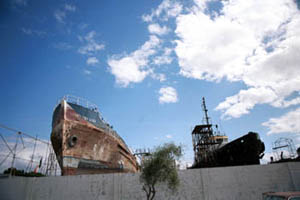 "The bottom line is that no one is going to
"The bottom line is that no one is going to
buy their tuna as long as they kill dolphins," says Mark Berman,
co-director of the International Monitoring Program at Earth Island Institute,
one of the plaintiffs in the action before Judge Henderson. "The
will of the American people is not to buy deadly tuna. They won't buy
it even if they bring it to this country"
The evidence of this can be found in Ensenada. Among the idled boats are General Zapata and Cartadeces, which helped give the tuna port its name. Each of these boats can capture between 1000 and 1200 tons of tuna and cost some 10 million dollars to build. Today the seagulls are their only visitors. But they are not only a reminder of what was, but what fishermen here believe can one day still be.
"Just like before," says Ruiz de la Toba. He sits in his living room, his eyes proudly lost in the picture that hangs on the wall. Twelve years younger, at the age of 43, Ruiz de la Toba is saving a dolphin while catching tuna.
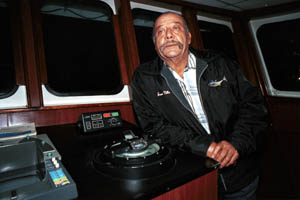 In
those days, Don Juan explains, fishermen would find schools of tuna by
looking for dolphin fins -many times by helicopter. In this area of the
Pacific Ocean, dolphins swim with tuna, protecting the fish from predator
sharks. "Tuna swim under dolphins
In
those days, Don Juan explains, fishermen would find schools of tuna by
looking for dolphin fins -many times by helicopter. In this area of the
Pacific Ocean, dolphins swim with tuna, protecting the fish from predator
sharks. "Tuna swim under dolphins
because sharks feed from tuna, but they [sharks] are scared of dolphins,"
Don Juan explains. "It was not until the 1950's that fishermen discovered
this."
This discovery highlights the irony underlying the embargo: dolphins die protecting tuna from one predator when they get caught in the net of another.
Fishermen would surround the tuna with circular "purse seine" nets, killing not only the tuna but also the many dolphins caught with them. In this way, 133, 000 dolphins were killed by countries fishing in the Eastern Pacific Ocean during 1986 (Mexico's fleet had the vast majority of catches.) After the embargo, Mexican fishermen adopted new techniques, allowing dolphins to escape the purse seines. Some fishermen even jump into the water to personally aid the dolphins out of the nets.
 Fishermen
have died in the process. But many dolphins have also been saved. By 1993,
the number killed had been reduced to 3,716. In 1998, 1900 dolphins were
killed. This represents a 97 percent reduction from the 1990 numbers.
Fishermen
have died in the process. But many dolphins have also been saved. By 1993,
the number killed had been reduced to 3,716. In 1998, 1900 dolphins were
killed. This represents a 97 percent reduction from the 1990 numbers.
These reductions helped bring about an end to the U.S. embargo in April of this year, but not to the problems for Mexican tuna fishermen. Because of the way in which the dolphins were caught and released, Earth Island and other U.S. Environmental organizations continued to argue that Mexican tuna should not be considered "dolphin-safe" - meaning this vital certification, so important to dolphin-friendly-consumers, would not appear on grocery tuna cans nor in the shipments to wholesalers.
The U.S. Commerce Department opposed this measure, arguing that tuna should be certified as "dolphin safe" if no dolphins were killed or seriously injured during a tuna catch. But Earth Island argued that the purse seine process, even with its modifications, "stresses" the dolphins, potentially affecting their reproductive capacity.
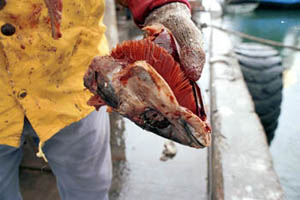 Earth
Island stated that "all tuna coming into the U.S. that is labeled
'Dolphin Safe' must comply with the strong standards originally developed
by Earth Island and U.S. tuna companies in 1990 -no dolphins may be chased
or netted during an entire fishing trip."
Earth
Island stated that "all tuna coming into the U.S. that is labeled
'Dolphin Safe' must comply with the strong standards originally developed
by Earth Island and U.S. tuna companies in 1990 -no dolphins may be chased
or netted during an entire fishing trip."
In April of this year, Judge Henderson, ten years after imposing the embargo, ruled with the environmental organizations. Though Mexican tuna is now allowed in U.S. Markets, it would be without the all-important "dolphin-safe" label.
Julia Carabias, then the Mexican Secretary of the Environment (SEMARNAP) denounced Judge Henderson's ruling, citing the free trade provisions of the World Trade Organization. "The label means practically the sale of the product," Carabias stated in a press release. "That lack of label is absolutely unfair competition and it is not free trade." If Mexico does not obtain "dolphin-safe" status, Carabias warned, Mexico may suspend their participation in the International Dolphin Conservation Program Act and file a complaint before the WTO.
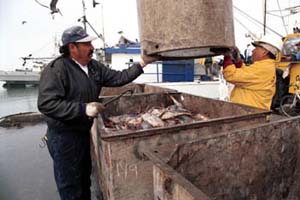 "If
they cannot sell their tuna here," added then U.S. Commerce Secretary
William Daley, "they are going to sell to countries that do not demand
levels of protection of the dolphin."
"If
they cannot sell their tuna here," added then U.S. Commerce Secretary
William Daley, "they are going to sell to countries that do not demand
levels of protection of the dolphin."
Environmentalists dismiss such talk. "Ridiculous," says Earth Island's Mark Berman, of Mexico's threat to abandon its participation in the dolphin protection program. "If they do so, Mexicans will never see a single ounce of tuna in the US." For Berman, even if the US government wins the appeal, Mexicans will not be able to sell their tuna.
Earth Island already has agreements with US Tuna processors, grocery stores, and restaurants. These "companies have pledged to buy and sell only 'dolphin safe' tuna caught without using deadly nets on dolphins."
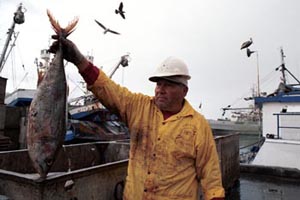 "Anyone
[US tuna Corporations] who buys tuna will be boycotted," he adds.
"Earth Island Institute will run ads in the New York Times and the
Washington Post. If we have to, we'll start the whole thing again, having
kids marching on the streets. We have done it before and we'll do it again.
It's not that hard."
"Anyone
[US tuna Corporations] who buys tuna will be boycotted," he adds.
"Earth Island Institute will run ads in the New York Times and the
Washington Post. If we have to, we'll start the whole thing again, having
kids marching on the streets. We have done it before and we'll do it again.
It's not that hard."
Environmentalists argue that Mexico should switch to a more expensive, high-tech technique known as FADS - (fish aggregating devices). With FADS, tuna fishermen set bait in buoys, which communicate by satellite to the boat as they attract tuna. This virtually eliminates incidental dolphin kills.
Ironically, Mexican fishermen claim the technique is environmentally damaging because so many other fish are killed in the process. "With FADS you kill everything there is," said Herrera Recio, who has fished for foreign boats that use FADS. "You also waste tons and tons of juvenile tuna," he added.
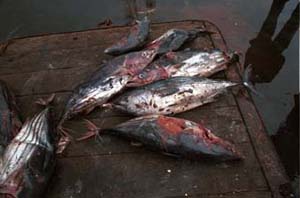 Mexican
officials agree. Referring to FADS in a September meeting in Washington,
Carlos Camacho Gaos, undersecretary of fishing for SEMARNAP, accused the
United States of "unsustainable fishing practices" because of
the "incidental capture of youthful tuna" and other marine life.
Mexican
officials agree. Referring to FADS in a September meeting in Washington,
Carlos Camacho Gaos, undersecretary of fishing for SEMARNAP, accused the
United States of "unsustainable fishing practices" because of
the "incidental capture of youthful tuna" and other marine life.
The old fisherman in Ensenada profess little knowledge regarding the long and tedious legal battles that idled their boats. About this matter Herrera Recio says, "We don't know much about the process, it is those guys from CANAIPESCA and SEMARNAP [Mexico's fisheries and environmental and agencies] that know all about it. They are the ones that go to Washington and New York, stay at fancy hotels, drink wine and shop for expensive clothes. All I can tell you about is how much the tuna fishermen from Ensenada have suffered due to the embargo."
Herrera Recio reserves some of his anger for U.S. environmental organizations, "These people from Earth Island and that judge," he says, "are putting the death of the dolphins in front of thousands of families."
 "Now
I work in Mazatlán," says the fishermen Ruiz de la Toba, explaining
how his life changed after the embargo. "I go there two or three
days before the boat leaves. We usually stay in the sea anywhere from
40 to 70 days without coming back to land. When we return I do not go
back to Ensenada because the trip is expensive; I stay in the boat in
Mazatlán for the next 8 to 10 days and then the boat leaves again.
When we come back the second time is when I get to visit my wife, my sons
and my grandchildren. Sometimes even more then three months can pass by
before I can see my family."
"Now
I work in Mazatlán," says the fishermen Ruiz de la Toba, explaining
how his life changed after the embargo. "I go there two or three
days before the boat leaves. We usually stay in the sea anywhere from
40 to 70 days without coming back to land. When we return I do not go
back to Ensenada because the trip is expensive; I stay in the boat in
Mazatlán for the next 8 to 10 days and then the boat leaves again.
When we come back the second time is when I get to visit my wife, my sons
and my grandchildren. Sometimes even more then three months can pass by
before I can see my family."
Despite his situation, Ruiz de la Toba acknowledges he is one of the few lucky ones. "Many are now working in the Maquiladoras, as taxi drivers, security guards. Many even had to cross to the US. None of them make enough money to live well."